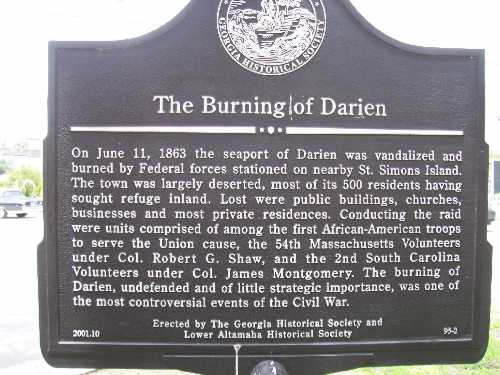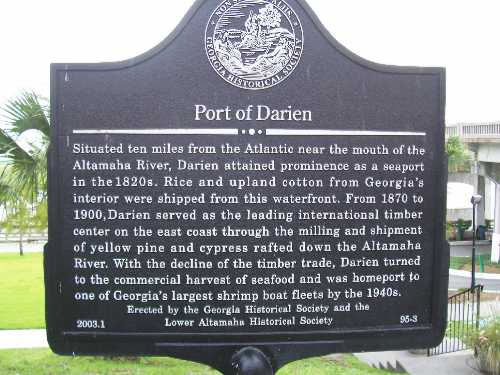Back to
Community Activities
Historical Markers
LAHS has
co-sponsored several historical markers in McIntosh County in cooperation with
the Georgia Historical Society. For a full list of markers visit
www.georgiahistory.com
|
Darien and its
Railroads |
(Echoes October 1999) |
|
Burning of Darien |
(Echoes October 2001) |
|
Sapelo Island |
(Echoes January 2003) |
|
Port of Darien |
(Echoes January 2003) |
|
Ashantilly |
10/25/2009 |
|
|
Darien and its
Railroads - Historical Marker
Click
here for an article on
Columbus Square Railroad Depot by Buddy Sullivan
In December 1999 a
historical marker was erected in Columbus Square, Darien, Georgia by the
Georgia Historical Society and the Lower Altamaha Historical Society.
Columbus Square Railroad Depot
In 1889 the Darien Shortline Railroad was organized
to transport yellow pine timber to the Darien sawmills from Georgia’s
interior. Originating in Tattnall County and continuing through
Liberty County, the Darien & Western line was completed in 1895 to its
terminus near this spot where a passenger depot was built, now marked
by the gazebo. In 1906 the line was bought by the Georgia Coast &
Piedmont Railroad, which extended the line 18 miles south to Brunswick
in 1914. The train depot was then moved from Columbus Square to the
riverfront near the present U.S. Highway 17 bridge. The depot burned
in 1971.
Erected by The Georgia Historical Society and the
Lower Altamaha Historical Society
|
|
|
The Burning of Darien
- Historical Marker
The marker was unveiled on the lawn of Darien City Hall, September 22, 2001. The marker was made possible by The Georgia Historical
Society and The Lower Altamaha Historical Society.
 The Burning of Darien The Burning of Darien On June 11, 1863 the
seaport of Darien was vandalized and burned by Federal forces stationed on
nearby St. Simons Island. The town was largely deserted, most of its 500
residents having sought refuge inland. Lost were public buildings,
churches, businesses and most private residences. Conducting the raid were
units comprised of among the first African-American troops to serve the
Union cause, the 54th Massachusetts
Volunteers under Col, Robert G. Shaw, and the 2nd South Carolina Volunteers under Col. James Montgomery. The burning
of Darien, undefended and of little strategic importance, was one of the
most controversial events of the Civil War.
Erected by
the Georgia
Historical Society and the Lower Altamaha Historical Society
|
|
|
Sapelo Island and Port of Darien -
Historical
Markers
Saturday, January 25, 2003; 10:00 a.m. Sapelo Visitors Center —
Meridian, Ga.
11:00 a.m. Welcome Center Darien, Ga.
LAHS dedicated two Historical Markers in Darien and McIntosh County on
Saturday, January 25. Following the unveiling ceremony for The Port
of Darien, a reception was held at the Welcome Center, Darien. These
markers are possible through the Historical Marker Program of the Georgia
Historical Society. The text for the markers are below:
Sapelo Island
Situated five miles to the east, Sapelo was
inhabited by Guale Indians 5,000 years ago and was the site of a 16th century Franciscan mission. During his ownership of Sapelo from
1802-1851, Thomas Spalding was a leading plainer of Sea Island
cotton and sugar cane. Slave descendants still
live on the island at Hog Hammock. Sapelo was owned by automotive
pioneer Howard E. Coffin, 1912-1934, and tobacco heir Richard J.
Reynolds, 1934-1964. The University of Georgia Marine Institute opened
on Sapelo in 1953. The State of Georgia bought the island in 1969.
Erected by the Georgia Historical
Society, the Sapelo Island National Estuarine Research
Reserve and the Lower Altamaha
Historical Society.
|
|
|
The Port of Darien
Situated ten miles from the
Atlantic near the mouth of the Altamaha River, Darien attained
prominence as a seaport in the 1820s.
 Rice
and upland cotton from Georgia’s interior were shipped from this
waterfront. From 1870 to 1900, Darien served as the leading
international timber center on the east coast through the milling and
shipment of yellow pine and cypress rafted down the Altamaha River.
With the decline of the timber trade, Darien turned to the commercial
harvest of seafood, and was homeport to one of Georgia's largest
shrimp boat fleets by the 1940s. Rice
and upland cotton from Georgia’s interior were shipped from this
waterfront. From 1870 to 1900, Darien served as the leading
international timber center on the east coast through the milling and
shipment of yellow pine and cypress rafted down the Altamaha River.
With the decline of the timber trade, Darien turned to the commercial
harvest of seafood, and was homeport to one of Georgia's largest
shrimp boat fleets by the 1940s.
Erected by
the Georgia
Historical Society and the Lower Altamaha Historical Society.
|
| |
|
|
Ashantilly
Dedication Program 10/25/09 |
| |
More on Markers
More than 2,000 markers have been erected since
the program was launched in 1951 by the now-defunct Georgia Historical
Commission and then run by the Department of Natural Resources. In 1998, the
state privatized the program and turned it over to the Georgia Historical
Society, which operates it now under a state contract with the Department of
Economic Development. Since then, the Society has approved 150 of the
free-standing instantly recognizable markers.
Today's silver and black, cast aluminum markers
bear the GHS seal and are not monuments, commemorative devices, memorials or
celebratory plagues. They are unassailably factual presentations about
significant people, events, buildings, and locations in Georgia history.
Each marker costs about $3,000, split between the
Georgia Historical Society and the sponsoring
organization............ Early in its involvement the
Georgia Historical Society was able to erect as many as twenty markers
annually, a number that since 2004 has declined to just twelve per year due to
reduction in state funding. Only about 30 percent of applications are
approved in any given year.
One of the Society's most unique and
mission-appropriate programs, the markers reach a broad and diverse audience
in ways that none of its many other programs can. Through the marker program
the Society preserves Georgia's history, educates Georgia's citizens and
visitors, and ensures a future for Georgia's rich past.
For more information about the Georgia Historical
Society's historical marker program, call
|